| [Contact info] | [Research] | [Publications] | [Courses] | [StudentsPlus] | [Curriculum vitae] | [PSU Biology] |

| [Contact info] | [Research] | [Publications] | [Courses] | [StudentsPlus] | [Curriculum vitae] | [PSU Biology] |

My major research focus is the viruses of the extremely thermophilic archaeon (also known as archaebacteria) Sulfolobus. These viruses are completely different, both in their structures and sequences, from any other known viruses. We are interested in how these viruses and their hosts function in geothermally heated hot springs at very high temperatures (80C = 176F) and high acidity (pH below 4). We use genetic, comparative genomic, structural and biochemical approaches to study these viruses. Recent results on the genetic analysis of SSV1, the best studied of these viruses, are published in Frontiers in Microbiology (Iverson and Stedman, 2013).
We also use these viruses as tools to develop molecular genetics for extremely thermophilic Archaea. The same viruses can also be used as expression vectors for novel enzymes from extreme thermophiles. I am also very interested in transcriptional regulation in Sulfolobus, since there are some very striking parallels to transcriptional regulation in eukaryotic cells, including humans. Sulfolobus is however a much more tractable system for studying these basal transcriptional mechanisms.
We collaborate with researchers at Humboldt State University and California State University Chico on the Boiling Springs Lake Microbial Observatory Project with a focus on viruses of extremophiles in this acidic hot lake. Recently we discovered a novel virus genome in Boiling Springs Lake that appears to have formed by an unprecedented RNA-DNA recombination. These viruses are widespread and have been "hiding in plain sight". The manuscript that described these viruses (Diemer and Stedman, 2012), won the BioMedCentral research award for best paper in 2012, sponsored by Antibodies Online. We have developed testable theories on how this recombination could have taken place (Stedman, 2013, also featured on the cover).
Recent results on virus silicification (the first step in the formation of virus fossils) were published in the Journal of Virology, the premier virology journal (Laidler et al., 2013). These results have far-reaching implications for not only virus fossilization but also virus dispersal and maybe even vaccine preservation. They have been written up in Astrobiology Magazine and are the subject of a provisional patent application.
Sulfolobus solfataricus:Sulfolobus solfataricus is one of the first extremely thermophilic archaea to be discovered (by Wolfram Zillig and Karl Stetter in Pisciarelli near Naples, Italy). It grows in terrestrial volcanic hot springs optimally at 80C (176F) and at low pH (3) and is the prototype thermoacidophile (loving heat and acid). It is an Archaea which means that it looks like a bacteria, but is really very different. In the case of transcription, Sulfolobus actually has a RNA polymerase which is much more similar to eukaryotic RNA polymerase (like the ones that you and I have) and basal transcription factors (see Bio338, Introduction to Molecular Biology) almost identical to eukaryotic ones. Sulfolobus is very easy to work with in the lab, which makes it a model system for study of thermoacidophiles and Archaea. Sulfolobus cells are covered by a hexagonally symmetric surface (S)-layer of glycoproteins. S-layers can be made in large quantities and could serve as templates for nano-deposition. |
|||||
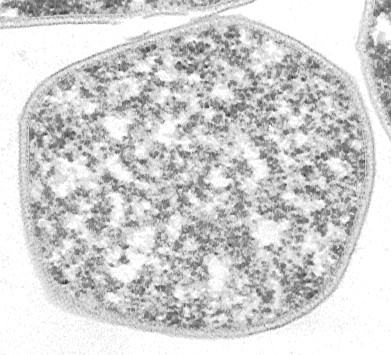 |
|||||
|
Sulfolobus solfataricus (D.Janckovik/W.Zillig)
|
|||||
Viruses of SulfolobusThe viruses of Sulfolobus found to date (see Zillig et al., 1999) have completely different structures and sequences than viruses which have been found until now (see Prangishvili et al., 2001 and Rice et al., 2001). Why they are so different is not clear. A major focus of my work is to determine what makes the viruses they way that they are, I use molecular biology to do this, but also collaborate with structural virologists and structural biologists who are trying to determine the structures of the viruses and their components. We are also interested in how similar and different viruses from different parts of the world are to each other. (Stedman et al., 2006). Viruses of extremophiles are also of interest for nanotechnology, both as templates for nano-fabrication but also as self-assembling systems. Their resistance to extreme environoments and novel structures make these viruses particularly interesting for such research. |
|||||
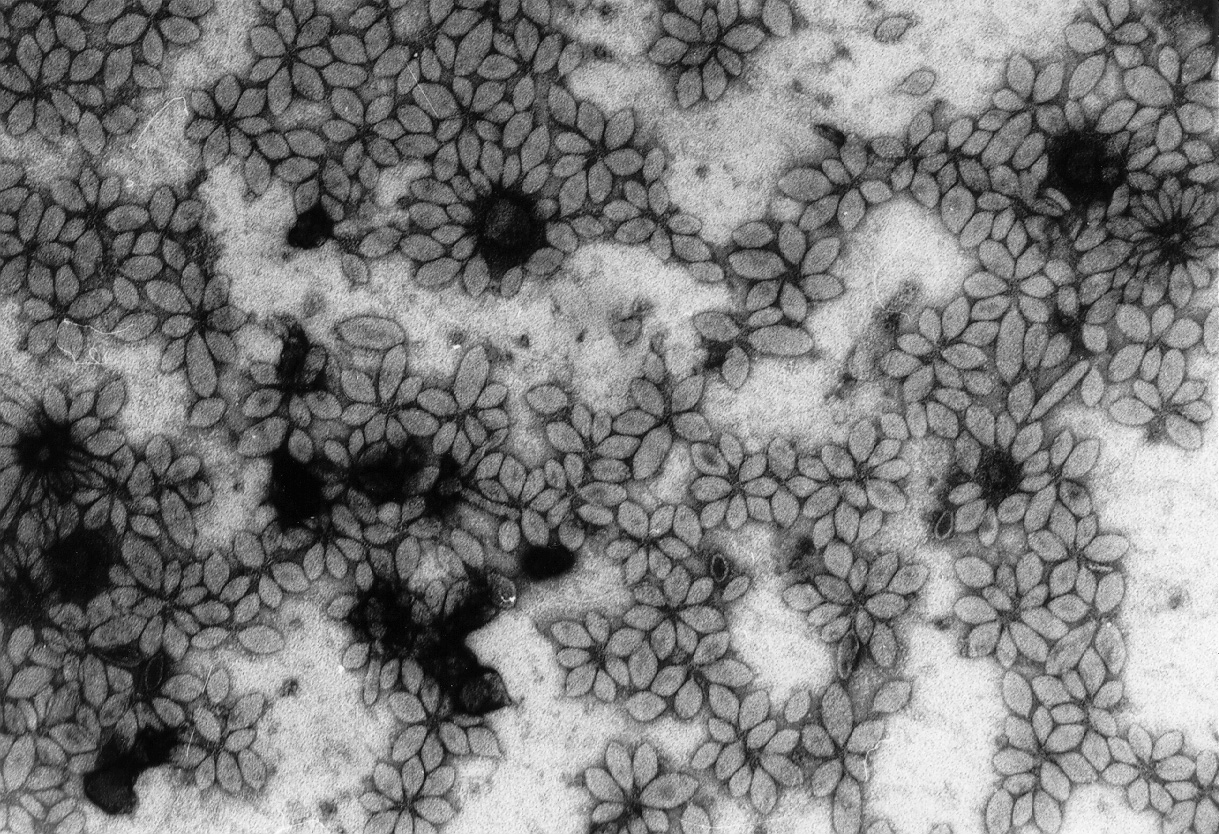 |
|||||
More Virus Pictures |
|||||
| SSV from Yellowstone National Park | |||||
Geothermal acidic hot springsHabitats for Sulfolobus are found more or less everywhere where there is volcanic activity. We work on organisms and viruses from Italy, Iceland, Yellowstone National Park, U.S.A., Kamchatka, Russia and New Zealand and our new favorite, Lassen Volcanic National Park. We have found that the virus populations and also the geochemistry vary greatly in these springs and are in the process of trying to find a correlation between these changes. This work involves the discovery of new viruses and determination of geochemistry. (Stedman et al., 2006) |
||||||
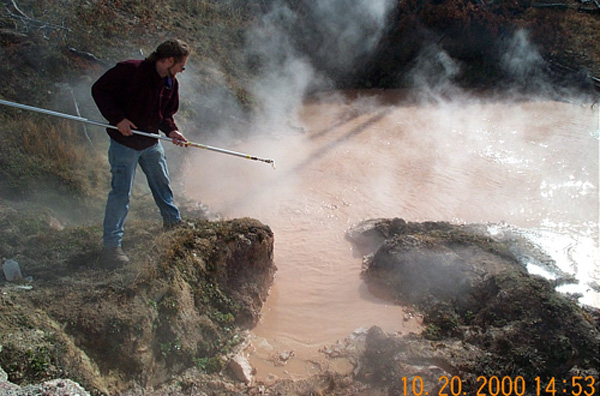 |
||||||
|
Rabbit Creek, Yellowstone National Park
|
||||||
More Hot Spring Pictures |
||||||
Molecular Genetics in SulfolobusThe complete genomic sequence of Sulfolobus solfataricus P2 has been determined. However there are many open reading frames in the genome with no characterized homologs. The only way to discover how these ORFs work is to use genetics. From the SSV1 virus of Sulfolobus a vector was made which can be used to transform Sulfolobus and express proteins from other organisms in Sulfolobus (Stedman et al., 1999). Recently we have developed a novel technique for specifically modifying the genome of the virus and used it to delete the virus integrase gene (Clore and Stedman, 2006). |
||||
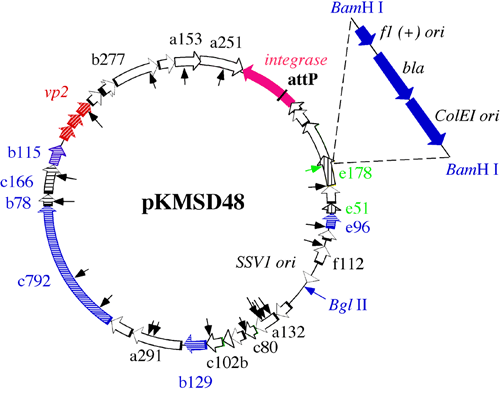 |
||||
| Shuttle Vector for Sulfolobus solfataricus and E.coli | ||||
Transcription in SulfolobusWolfram Zillig and his group originally showed that the RNA polymerase from Sulfolobus was more similar to eukaryotic RNA polymerase. This work has been continued by a number of labs which have shown in many in vitro experiments that the basal transcription factors of Sulfolobus are very similar to eukaryotic factors, but like the polymerase, many fewer proteins are required. However no one has been able to determine how transcriptional regulation works in the cell, in vivo. Using the vector developed in Stedman et al., 1999 in vivo transcription will be studied. |
|||||
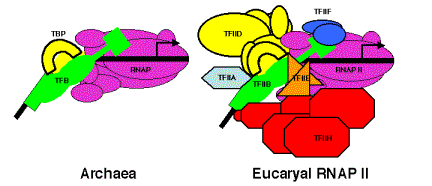 |
|||||
|
From Dr. Steve Bell.
|
|||||
Canadian Broadcasting Corporation: “The Virus Hunters” broadcast, March. 2007. (Link)
California Wild, “The Search for Aliens on Earth” Summer 2004 (Link)
U.S. News and World Report, June 17th, 2002, pages 58-59 (Link)
The Oregonian, Science Section, 21 August 2002
Astrobiology News, August 5th, 2002 (Link)
A. Clore and K. Stedman. The SSV1 viral integrase is not essential. (2007) Virology, 361, 103-111.
D. Prangishvili, K.M. Stedman, and W. Zillig. Viruses of the extremely thermophilic archaeon Sulfolobus. (2001) Trends in Microbiology 9/1, 39-43.
G. Rice, K. Stedman, J. Snyder, B. Wiedenheft, D. Willits, S. Brumfield, T. McDermott, and M. Young. Novel Viruses from Extreme Thermal Environments. (2001) Proc. Natl. Acad. Sci. U.S.A. 98/23, 13341-5. (Link)
K. M. Stedman, C. Schleper, E. Rumpf, and W. Zillig. Genetic Requirements for the Function of the Archaeal Virus SSV1 in Sulfolobus solfataricus: Construction and Testing of Viral Shuttle Vectors. (1999) Genetics, 152/4, 1397-1405. (Link)
K. M. Stedman, A. Clore and Y. Combet-Blanc. (2006) Biogeographical Diversity of Archaeal Viruses, In: SGM symposium 66: Prokaryotic diversity: mechanisms and significance (N. A. Logan, H.M. Pappin-Scott, and P.C.F. Oynston Eds). 131-144. Cambridge University Press, Cambridge.
W. Zillig, K.O. Stetter, S. Wunderl, W. Schulz, H. Preiss, and I. Scholz. The Sulfolobus-"Caldariella" Group: Taxonomy on the Basis of the Structure of DNA-Dependent RNA Polymerases (1980) Archives of Microbiology, 125, 259-269.
W. Zillig, H. P. Arnold, I. Holz, D. Prangishvili, A. Schweier, K. Stedman, Q. She, H. Phan, R. Garrett, and J. K. Kristjansson. Genetic Elements in the Extremely Thermophilic Archaeon Sulfolobus. (1998) Extremophiles, 2/3, 131-140.